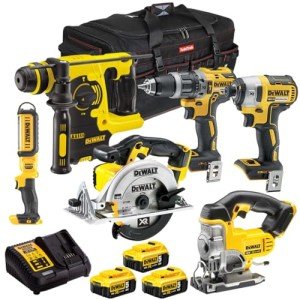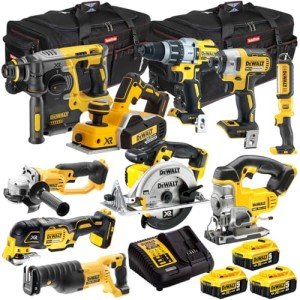
Electric Tool Kit
Overview
-
Sectors IT sector
-
Posted Jobs 0
Company Description
How To Explain Battery Powered Tool Set To Your Grandparents
Comprehensive Guide to Battery-Powered Tool Sets
In current years, battery-powered tools have transformed the way both experts and DIY enthusiasts approach their projects. With their convenience and efficiency, battery-powered tool sets have become a staple in workshops across the country. This post looks into the advantages of battery-powered tools, vital parts, comparisons, and answers to some often asked concerns.
Why Choose Battery-Powered Tool Sets?
Battery-powered tools offer numerous advantages over their corded counterparts:
-
Portability: Without the barrier of a cable, battery-powered tools can be easily carried and used anywhere.
-
Convenience: Quick setups remove the requirement for outlet access, making them perfect for outdoor jobs.
-
Lowered Trip Hazards: The lack of cords enables a safer work area, particularly in crowded or chaotic environments.
-
Technological Advancements: Most modern-day battery-powered tools feature effective lithium-ion batteries that offer longer runtimes and faster charging times.
Key Components of a Battery-Powered Tool Set
A typical battery-powered tool set might include numerous tools tailored to fulfill the needs of various jobs. Below is an extensive table showcasing standard tools discovered in these sets:
| Tool | Purpose | Typical Battery Voltage | Common Brands |
|---|---|---|---|
| Drill/Driver | For drilling holes and driving screws | 12V to 20V | DEWALT, Makita, powertoolsonline Milwaukee |
| Circular Saw | For cutting wood, plywood, and other materials | 18V to 20V | Bosch, Ryobi, Black+Decker |
| Reciprocating Saw | For demolition and rough cuts in numerous products | 18V | Porter-Cable, Hitachi |
| Effect Driver | For driving large screws/fasteners | 12V to 20V | Artisan, Ridgid |
| Sander | For smoothing surface areas and finishing wood | 12V to 20V | Ryobi, Milwaukee |
| Angle Grinder | For cutting and grinding metal, masonry, and tiles | 18V | Makita, DEWALT |
| Jigsaw | For elaborate cuts in wood, plastic, and metal | 12V to 20V | Black+Decker, Bosch |
Noteworthy Features to Consider
When selecting a battery-powered tool set, a number of features can boost use and performance:
-
Battery Life: Look for tools with lithium-ion batteries that offer longer runtimes and charge rapidly.
-
Interchangeability: Some tool sets enable battery compatibility across numerous tools, decreasing the need for multiple batteries.
-
Weight: Consider the ergonomics; lighter tools can minimize fatigue during comprehensive use.
-
Resilience: Robust building and construction and protective functions (like dust and water resistance) ensure the durability of the tools.
-
Warranty and Support: Good brands normally offer service warranties that cover problems and offer consumer support for queries.
Comparing Battery-Powered Tools to Corded Tools
The option in between battery-powered and corded tools often comes down to individual choice and project requirements. Here’s a contrast:
| Feature | Battery-Powered Tools | Corded Tools |
|---|---|---|
| Mobility | High – can be utilized anywhere | Limited – requires proximity to power outlets |
| Runtime | Restricted by battery life | Continuous as long as plugged in |
| Power Output | Usually less effective than corded | Typically more powerful |
| Maintenance | Requires battery care | Lower maintenance; more straightforward |
| Price | Usually higher initial investment | More affordable for specific tools |
| Flexibility | Lots of multi-purpose tools readily available | Specialized tools available |
Best Practices for Using Battery-Powered Tool Sets
To make the most out of a battery-powered tool set, follow these best practices:
-
Charge Batteries Regularly: To ensure maximum battery life, prevent deep discharging and charge batteries after each usage.
-
Clean Tools After Use: Keeping your tools clean decreases wear and tear and can help protect their lifespan.
-
Store Safely: Keep tools in a dry, protected location to avoid damage and guarantee easy access.
-
Check Out User Manuals: Each tool may have particular operating directions or upkeep tips; reading the handbook can save time and disappointment.
Regularly Asked Questions (FAQs)
1. For how long do battery-powered tools last?
The life-span of battery-powered tools depends upon use and maintenance but can last several years with appropriate care. Lithium-ion batteries generally last 2-3 years, depending upon charging practices.
2. Can I use my battery-powered tools in cold weather condition?
Severe cold can affect battery efficiency. It’s best to keep batteries at space temperature when not in use and allow them to warm up before use in cold conditions.
3. Are all battery-powered tools suitable with the same battery?
Not always. Battery compatibility typically depends upon the brand and particular tool design. It’s vital to confirm compatibility before acquiring additional tools.
4. How do I keep lithium-ion batteries?
To keep lithium-ion batteries, avoid complete discharges, keep them cool, and charge them after usage. It’s likewise encouraged to use the maker’s charger.
5. What are the most essential tools for a newbie?

For beginners, a drill/driver, circular saw, and impact motorist are typically the most essential tools to begin with, as they cover a wide variety of standard projects.
Battery-powered tool sets have changed how we approach traditional tasks, offering a mix of convenience and efficiency. Whether for expert trades or DIY home enhancements, these tools accommodate varied project needs. By understanding the features, parts, and best practices associated with battery-powered tools, users can optimize their performance and efficiency. Equipped with this extensive guide, both newbies and experienced experts can now make notified decisions when selecting their next tool set.
